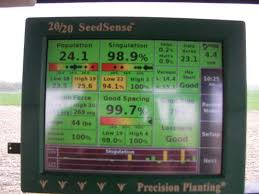What is Precision Ag? Why is it important to know what it is and what it does? How does it affect the food we buy at the grocery store? What part does it play in our food security? Well these are all good questions, and I will do my best to answer them the best that I can.
 |
| Yield Map |
So what exactly is precision Ag? Precision Ag is the use of technology such as GPS guided auto-steer, variable rate fertilizer, variable rate seeding, yield mapping, satellite imagery, topography etc. to to allow for closer, more site-specific management of factors affecting crop production. I will explain in more detail about these technologies in later posts. Precision Ag is going from a "one recommendation fits all" approach to treating different areas in a field differently according to what that area specifically needs.
 |
| Planting Monitor |
You may be thinking, "well that is interesting, but what how does that really affect me?" Farmers use precision Ag to increase their crop yields, profitability, and to be good stewards of their land. To do this, farmers are using precision Ag components to put the right amount of fertilizers and the right seed hybrids on the right spots of their fields to increase their yields. Putting the right amounts of fertilizers in the right areas is also better for the environment vs using the same rate across the whole field, putting only the required amounts in each area ensures that we are not putting excessive amounts on an area that will not utilize them. Besides striving for increases in yield, farmers are constantly striving to produce the highest quality product at a reasonable cost. So what exactly does this mean to you, the consumer? The answer is ultimately higher quality food products at a reasonable price, all while being careful not to over apply and cause a loss of nutrients.
Another very important part of precision Ag is its how it affects food security. The definition of food security is the "sustained production and distribution of safe and nutritious food in quantities and quality in order for people to have healthy lives."
(Russo, J. (March 2009). Technology To The Rescue. In www.precisionag.com. Retrieved July 10, 2012, from http://www.precisionag.com/viewpoints/joerusso/?storyid=1509#.) Precision Ag directly contributes to food security from a more consistent performance at the point of production.
 |
| RFID tag next to Rice Grain |
Precision Ag is just beginning to impact the "safe and nutritious food" part of the definition. This part requires the ability to track food from the field to the consumer. One way this is starting to be used is using RFID (radio frequency identification) tags in produce that allows the tracking from production to your table. Using this technology to track from the point of production allows us to catch any issues that might happen anywhere in the chain from production to consumer.
While these few topics we have discussed are just a fraction of the uses for technology in agriculture, the effects can be very beneficial to both the producer and the consumer. Precision Ag helps the producers control their input costs by only applying the amounts of inputs needed to maximize their crop yields, this also ensures that we are not over applying products like fertilizers which could cause undesired run-off to off site areas. I would sum it up by saying that precision Ag allows producers to save money, maximize production and contribute vast amounts of safe food to the world to feed the ever increasing population.
 |
| Precision Ag Cycle |

